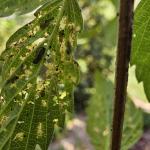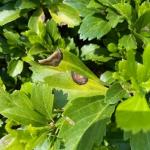UMass Extension's Landscape Message is an educational newsletter intended to inform and guide Massachusetts land care professionals in the management of our collective landscape. Detailed reports from scouts and Extension specialists on growing conditions, pest activity, and cultural practices for the management of woody ornamentals, trees, and turf are regular features. The following issue has been updated to provide timely management information and the latest regional news and environmental data.
Welcome to Landscape Message #7 for the 2024 growing season. The next message will be published in one week, on May 31. To receive immediate notification when the next Landscape Message update is posted, be sure to join our e-mail list
Click on the headings below to jump to that section of the message.
In This Issue
Scouting Information by Region
Woody Ornamentals
Scouting Information by Region
Environmental Data
The following data was collected on or about May 22, 2024. Total accumulated growing degree days (GDD) represent the heating units above a 50ºF baseline temperature collected via regional NEWA stations (http://newa.cornell.edu) for the 2024 calendar year. This information is intended for use as a guide for monitoring the developmental stages of pests in your location and planning management strategies accordingly.
|
MA Region/Location |
2024 Growing Degree Days |
Soil Temp |
Precipitation |
Time/Date of Readings |
||
| Gain since last report |
2024 total |
Sun |
Shade |
|||
|
CAPE |
44 |
120 |
63 |
55 |
1.96 |
12:00 PM 5/22/2024 |
|
SOUTHEAST |
74 |
216 |
75 |
60 |
1.90 |
3:00 PM 5/21/2024 |
|
NORTH SHORE |
59 |
142 |
62 |
56 |
0.36 |
10:30 AM 5/22/2024 |
|
EAST |
77 |
219 |
81 |
68 |
1.03 |
3:00 PM 5/22/2024 |
|
METRO |
83 |
222 |
57 |
54 |
0.60 |
6:00 AM 5/20/2024 |
|
CENTRAL |
89 |
229 |
62 |
58 |
2.70 |
11:00 AM 5/22/2024 |
|
PIONEER VALLEY |
104 |
278 |
69 |
62 |
1.13 |
12:00 PM 5/22/2024 |
|
BERKSHIRES |
95 |
232 |
66 |
60 |
0.49 |
5:30 AM 5/22/2024 |
|
AVERAGE |
78 |
207 |
67 |
59 |
1.27 |
- |
|
n/a = information not available |
||||||
US Drought Monitor: Once again, no change from last week... at this time, no area of Massachusetts is under official drought status. State map as of Thursday 5/23: https://droughtmonitor.unl.edu/CurrentMap/StateDroughtMonitor.aspx?MA
Phenology
| Indicator Plants - Stages of Flowering (BEGIN, BEGIN/FULL, FULL, FULL/END, END) | ||||||||
|---|---|---|---|---|---|---|---|---|
| PLANT NAME (Botanic / Common) | CAPE | S.E. | N.S. | EAST | METRO W. | CENT. | P.V. | BERK. |
|
Weigela florida (old fashioned weigela) |
* |
Begin |
* |
* |
* |
* |
Begin |
* |
|
Robinia pseudoacacia (black locust) |
* |
* |
* |
* |
* |
* |
Begin |
* |
|
Syringa meyeri (Meyer lilac) |
Begin |
* |
Begin/Full |
Begin |
Begin |
Begin |
Full |
Begin/Full |
|
Deutzia spp. (deutzia species) |
Begin |
End |
Begin |
Begin/Full |
* |
* |
Begin/Full |
Begin/Full |
|
Aesculus hippocastanum (common horsechestnut |
Full |
Begin |
Full |
Full |
Full |
Begin |
Begin/Full |
Full |
|
Enkianthus campanulatus (redvein enkianthus) |
* |
Begin |
Full |
Begin |
* |
* |
Full |
* |
|
Rhododendron carolinianum (Carolina rhododendron) |
Begin/Full |
* |
Full |
Begin/Full |
Begin |
Full |
Begin/Full |
Begin/Full |
|
Rhododendron catawbiense (catawba rhododendron) |
Begin |
Begin/Full |
Begin/Full |
Begin |
Begin |
Begin |
Begin/Full |
Begin |
|
Elaeagnus umbellata (autumn olive) |
Full |
Full |
Full |
Full |
Full |
Full |
Full |
Full |
|
Spiraea x vanhouttei (Vanhoutte spirea) |
End |
End |
Full |
Full/End |
End |
End |
Full/End |
Full |
|
Syringa vulgaris (common lilac) |
Full |
Full/End |
Full |
Full/End |
End |
Full/End |
Full/End |
Full |
|
Cornus florida (flowering dogwood) |
Full |
Full/End |
Full/End |
Full/End |
Full/End |
Full |
Full/End |
Full |
| * = no activity to report/information not available | ||||||||
Regional Notes
Cape Cod Region (Barnstable)
General Conditions:
The average temperature for the period from May 15 - May 22 was 55ºF with a high of 77ºF on May 22 and a low of 47ºF on May 21. From May 15 – May 20, temperatures were primarily in the 50s and cloudy. Nearly 2 inches of precipitation was recorded during the period, with the majority on May 15, 16, and 18. Soil moisture is adequate. The period ended warmer, brighter and dry.
Herbaceous plants seen in bloom during the period include basket of gold (Aurinia saxatilis), moss phlox (Phlox subulata), sweet woodruff (Galium odoratum), bleeding heart (Lamprocapnos spp.) and some bearded iris (Iris x germanica). Woody plants seen in bloom during the period include azalea, crabapple (Malus spp.), red bud (Cercis canadensis), beach plum (Prunus maritima), dwarf fothergilla (Fothergilla gardenii), and wisteria (Wisteria spp.). Pollen from oaks in the red oak group is abundant.
Pests/Problems:
Box tree moth was discovered in several towns of the upper Cape last season. This insect is capable of defoliating boxwood if left unmanaged. Box tree moth is active and should be scouted for.
Be on the lookout for southern pine beetle (SPB). SPB, while similar to black turpentine beetle, produces smaller pitch tubes higher on the trunk.
Insect pests observed during the period include box tree moth caterpillars on boxwood, boxwood leafminer larvae on boxwood (soon to pupate, still), hemlock elongate scale on hemlock, winter moth on various trees and shrubs, black turpentine beetle adults on pitch pine, hydrangea leaftier on smooth hydrangea, viburnum leaf beetle on arrowwood viburnum, dogwood sawfly on alternate leaf dogwood, and azalea leafminer on ‘PJM’ rhododendron.
Beech leaf disease, which is widespread on ornamental and American beech, is readily visible on emerging foliage, or lack thereof. Disease symptoms or signs observed during the period include brown rot on weeping cherry, sycamore anthracnose on sycamore, volutella blight on boxwood, leaf spot on hosta, white pine needle decline on white pine, needlecast on pitch pine, rhizosphaera on spruce and fir, and holly rust on holly; cedar apple rust teliohorn galls were active early last week and red thread is active in turf.
Seasonal leaf drop on holly has begun, often mistaken for disease-related leaf drop. Many inquiries have come in about damage to bigleaf hydrangea caused by freezing temperatures on April 26. Deer and rabbit damage to hosta continues. Slugs and snails are active.
Invasive plants seen in bloom during the period include leafy spurge (Euphorbia esula), scotch broom (Cytisus scoparius), shrub honeysuckles (Lonicera spp.), and autumn olive (Elaeagnus umbellata). Other weeds seen in bloom include narrow-leaved plantain (Plantago lanceolata), red sorrel (Rumex acetosella), white clover (Trifolium repens), black medic (Medicago lupulina), and buttercups (Ranunculus spp.).
Southeast Region (Dighton)
General Conditions:
The high temperature over the week past, since May 15, was 72ºF on Friday afternoon. The mornings of Monday, May 20, and Tuesday the 21st saw the week's lows of 52ºF. There were heavy rains on Wednesday, May 15th, through the following Thursday and a lighter shower the morning of Saturday, May 18. Overall, precipitation measured 1.90 inches for the week. The highest wind speeds were northeast at 16 mph on Thursday, May 16th. During the past two weeks, the temperature averaged 57ºF while humidity was 84%. The soil temperature in full sun measured 75ºF and in shade 60ºF at 3:00 PM Wednesday, May 21st.
Plants currently in flower include: Aesculus hippocastanum (common horse chestnut), Cornus florida (flowering dogwood), Deutzia spp. (Deutzia species), Elaeagnus umbellata (Autumn-olive), Enkianthus campanulatus (redvein Enkianthus), Euonymus alatus (winged euonymus), Lonicera tatarica (Tatarian honeysuckle), Rhododendron catawbiense (Catawba rhododendron), Rhododendron spp. (early azaleas), Spiraea x vanhouttei (Vanhoutte spirea), Syringa vulgaris (common lilac), and Weigela florida (old fashioned weigela).
North Shore (Beverly)
General Conditions:
This reporting period was the second week of with minimal precipitation recorded at Long Hill in Beverly MA. Quick rain shower activity passed through on May 16th and 20th and dropped 0.36 inch of rain. Because of low rainfall in the past weeks, it is important to water recently planted trees, shrubs and perennials. The average daily temperature was 58ºF with the highest temperature of 85ºF recorded on May 22 and the lowest temperature of 44ºF recorded on May 20th. Conditions were very conducive for outdoor activities and yard work. Lawns are green and there is plenty of color in the landscape. Many azaleas and flowering dogwoods are bursting with color. Woody plants seen in bloom include: silver bell (Halesia carolina), Wright viburnum (Viburnum wrightii), pearlbush (Exochorda racemosa), redvein Enkianthus (Enkianthus campanulatus), flowering dogwood (Cornus florida), redbud (Cercis canadensis), little leaf lilac (Syringa microphylla), common lilac (Syringa vulgaris), common horse chestnut (Aesculus hippocastanum), many azaleas and rhododendrons, highbush blueberry (Vaccinium corymbosum), golden chain tree (Laburnum anagyroides), and Scotch laburnum (Laburnum alpinum). Herbaceous plants in bloom include: Scotch rose (Rosa spinosissima), Father Hugo rose (Rosa hugonis), Allium (Allium spp.) honesty plant (Lunaria annua), trillium (Trillium spp.), avens (Geum spp.), forget-me-not (Myosotis scorpioides), Vinca vine (Vinca major), bleeding heart (Lamprocapnos spectabilis), tree peony (Paeonia suffruticosa), and fetterbush (Leucothoe fontanesiana).
Pests/Problems:
Young larvae of rose slug sawfly (Endelomyia aethiops) were observed on rose bushes. The larvae are still very small, and they can be easily managed by insecticidal soap spray. Make sure to spray both sides of the leaves. Spinosad is also effective against sawfly larvae, whereas Btk is not. Note that spinosad is toxic to pollinators when it is wet and should not be applied to blooming plants. Once the product has dried, it is no longer toxic to pollinators. Very young larvae of viburnum leaf beetles (Pyrrhalta viburni) were observed on American cranberry viburnum and starting to cause some damage on the leaves of this and other susceptible Viburnum cultivars. Control viburnum leaf beetle larvae before they become larger by applying spinosad or insecticidal soap or other registered pesticides. Dandelion (Taraxacum officinale) seeds have matured and are being blown by wind over the landscape. Other weeds observed in bloom include ground ivy (Glechoma hederacea), garlic mustard (Alliaria petiolata), deadnettle (Lamium purpureum), common chickweed (Stellaria media), and common groundsel (Senecio vulgaris). Mosquitoes and ticks are very active. Protect yourself with a repellent when working outdoors.
East (Boston)
General Conditions:
We had another good week of growing conditions for landscape plants. We accumulated 1.03 inches of precipitation with the majority, 0.73 inches, falling on May 16th. Daytime temperatures averaged 66ºF; the average includes extremes of 56ºF on the 19th followed by a high of 86ºF on May 21st. We are at 192 GDD’s (base 50). Plants are putting on plenty of new growth. Some plants in bloom include; Actinidia kolomikta (artic kiwi), Aesculus pavia (red buckeye), Aquilegia canadensis (eastern red columbine), Aquilegia vulgaris (common columbine), Cornus x rutgersensis (hybrid flowering dogwood), Halesia carolina (Carolina silverbell), Iris germanica (bearded iris) and Luecothoe fontanesiana (doghobble).
Pests/Problems:
Viburnum leaf beetle larvae (Pyrrhalta viburni) have begun feeding on the foliage of the native Viburnum dentatum (arrowwood Viburnum) and Viburnum opulus var. Americana (American cranberrybush Viburnum) as well as other susceptible Viburnums. There appears to be a significant population of snowball aphids (Ceruraphis viburnicola) that are particularly attracted to Viburnum carlesii (Koeanspice viburnum). I have observed the tell-tale contorted leaves on every Koreanspice viburnum I have come across, regardless of its past history with the insect. Whitchhazel cone gall aphids (Hormaphis hamamelidis) have begun creating their cone galls on whitchhazel (Hamamelis spp.) foliage. Powdery mildew (Sphaerotheca pannosa var. Rosae) was visible on roses (Rosa spp.) beginning May 21 and 22, in correlation with the rise in humidity. The problematic, perennial landscape and turf weed, yellow nutsedge (Cyperus esculentus) continues to gain height. Maple (Acer spp.) and cherry (Prunus spp.) seedlings continue to germinate in mulched beds.
Metro West (Acton)
General Conditions:
We experienced summer-like temperatures during this reporting period. Temperatures soared into the upper 70s and into the 80s with a high temperature of 88ºF recorded on the 21st and thankfully, there was some relief when temperatures dipped overnight with several low temperatures of 46º recorded. The average monthly rainfall for May is 4.04” and as of the 21st, only 1.5” has been recorded for the month in this area. The landscape is exploding with color! A small sample of plants observed in some stage of bloom this past week were the following: Aesculus hippocastanum (horsechestnut), Aesculus × carnea 'Briotii' (red horse chestnut), Allium schoenoprasum (chive), Amsonia hubrichtii (Arkansas blue star), Aronia arbutifolia (black chokecherry), Convallaria majalis (lily of the valley), Cornus sericea (redosier dogwood), Dicentra spectabilis (old fashioned bleeding heart), and Viburnum plicatum var. tomentosum (doublefile viburnum).
Pests/Problems:
We can now add Euonymous alatus (burning bush), a small shrub seen growing in the woodland understory and in landscaped properties, to our list of woody invasive plants in bloom. Also on that list are: Berberis thunbergii (barberry), a small shrub found growing in the wild, as well as frequently discovered planted in landscapes, with insignificant flowers; Elaeagnus umbellata (Autumn-olive), a shrub/small tree that can easily be detected by its silvery leaves, light yellow fragrant flowers, and thorny branches; and Lonicera maackii (Amur honeysuckle), a shrub with delicate white/yellow flowers. Alliaria petiolata (garlic mustard) continues to flower and is in full bloom... it can be easily spotted because of its white flowers and can be seen growing anywhere and everywhere including on roadsides and in woodlands, wetlands, and gardens. Aphids and the resulting distorted leaves they cause are evident on Viburnum.
Central Region (Boylston)
General Conditions:
A cooler week with rain previously, though the heat has sprung up along with high humidity. Max precipitation was 1.43 inches on the 16th, averaging 4.35 inches for the month of May so far. Temperatures have averaged around 77ºF in the last week, the highest being 96.3 on the 21st. Despite the rain, the high temps seem to dry things out fast. Some woody plants that can be seen blooming currently are: red buckeye (Aesculus pavia), Magnolia ‘Yellowbird’, Aronia spp., and azaleas such as Pinxterbloom Azalea (Rhododendron periclymenoides), swamp azalea (Rhododendron viscosum), and pink-shell azalea (Rhododendron vaseyi). Some herbaceous material that also can be seen blooming includes: Phlox spp. (creeping and woodland phlox), chives (Allium schoenoprasum), Cusick's camass (Camassia cusickii), green and gold (Chrysogonum virginianum), golden groundsel (Packera aurea), and Geranium spp.
Pests/Problems:
Common unwanted plants such as dandelions, garlic mustard, burning bush, and knotweed can be still seen across the landscape and removal efforts are ongoing, as the growing season goes. Slugs and aphids have made a comeback, especially the slugs, creating a lot of foliage damage. Lastly, a major hit has been made on the American beech trees (Fagus grandifolia) with beech leaf disease (BLD). Though experimental, treatments have been conducted on some select trees in the previous year, though this has shown no sign of stopping the destruction. This year, the stages of BLD can be present on both young and older trees and therefore estimate how long the trees have had the pathogen. Within the area, a lot of the smaller to medium trees have completely lost their foliage due to this. Larger specimens have more striping and loss of foliage compared to last year, and unfortunately it seems that it only will progress. After defoliation, the trees will send out new foliage, though dieback will most likely continue throughout the season.
Pioneer Valley (Amherst)
General Conditions:
This tremendously colorful spring continues to dazzle in the Pioneer Valley. An array of rhododendrons, azaleas, and herbaceous perennials are now in peak flower. Conifers are draped in new growth. As we make our way into the home stretch of May, high temperatures and humidity have really started to climb. The mercury peaked at 90ºF on 5/22 with dew points in the upper 60s, causing a burn on some tender new growth in full sun. But we continue to experience a heavy dose of cloud cover intermixed with periods of sun and clear skies. Scattered showers across the tri-counties occurred on 5/15–5/16, with accumulations ranging from 0.25” to >1”. Strong, isolated bands of thunderstorms (with hail) on 5/21 dumped >1.5” in the Greenfield area. Overall, soil moisture is good across the landscape with supplemental irrigation only necessary for new transplants. The distinctive trills of the gray treefrog (Hyla versicolor) have been regularly heard in the late afternoon and early evening hours. Red maple samaras are spent and oak catkins are falling.
Pests/Problems:
Symptoms and reports of beech leaf disease (BLD) continue to develop in the area. Canopy dieback typically begins in the lower canopy and spreads upwards. The interveinal banding appears dark green on American beech (Fagus grandifolia) but may appear a purplish red on European beech (F. sylvatica). Additional symptoms include undersized, distorted leaves and a blight of the buds, meaning no leaves were produced this season. Woolly beech aphid (Phyllaphis fagi) appears to be common once again this season on European beech. Infestations can result in curled and distorted foliage that is covered in honeydew (aphid waste product). While unsightly, this pest often does not warrant management. Eastern tent caterpillar (Malacosoma americanum) is abundant this spring on black cherry (Prunus serotina) and crabapple (Malus sp.). Scattered leaf chewing and defoliation of tender new growth has been observed on oak and maple from unknown green caterpillars. Mosquitoes have emerged in a big way over the past two weeks and bee and wasp activity is very high overall. Be mindful not to overhead irrigate on sunny days from late morning into early afternoon. Water droplets on deciduous leaves can result in a foliar burn. Fruiting bodies of Cerioporus squamosus (Dryad’s Saddle) and Kretzschmaria deusta (Burnt Crust Fungus) can be found right now. The latter is most common on large European beech and sugar maple.
Berkshire Region (West Stockbridge)
General Conditions:
Despite a month still to go before the arrival of summer, temperatures on May 21 and 22 felt more like summer than spring. High temperatures for the week were: 87ºF in North Adams on 5/22, while Richmond and Pittsfield recorded highs of 85ºF on both 5/21 and 5/22. The low temperatures were all on May 17: 46ºF in Richmond, 47ºF in Pittsfield, and 48ºF in North Adams. The average temperature for the week was much higher than in the previous week as Pittsfield and Richmond averaged 63.3ºF and 63.2ºF respectively. The average for the week in North Adams was 65.9ºF. A bit of a cool down is expected over the next week. Rainfall for the week was scant with 0.29 inches in North Adams, 0.49 inches in Richmond, and 0.52 inches in Pittsfield. Still, soil moisture remains good, at least below the upper inch of soil. Moisture should be no problem as rain showers are expected on 4 or 5 days till May 30. Growth of turf has been rapid while flower development on a wide range of ornamental trees, shrubs, and herbaceous plants has been nothing short of spectacular. Soil temperature has risen by 5 degrees over the past week and, along with the moisture, it has promoted plant development.
Pests/Problems:
Plant pest problems, other than aggressive weed growth, have not yet been much of a problem. Spongy moth (Lymantria dispar) caterpillars have been observed at a few sites but is far from the numbers seen a few years ago. Other pests include aphids on a variety of plants including woody plants, leaf tiers on hydrangea and gray dogwood (Cornus racemosa), wooly beech aphid (Phyllaphis fagi) on copper beech (Fagus sylvatica 'Purpurea'), and Eastern tent caterpillar (Malacosoma americanum). Spruce spider mites were found on a dwarf Alberta spruce (Picea glauca ‘Conica’), aphids on several herbaceous and woody plants, and scale on a plum tree. Spittlebugs can now be seen on many plants; they cause little problem. Likewise, hickory leaf stem galls, now observed on a shagbark hickory (Carya ovata), are not considered to be a serious pest. Slug and snail activity is high and causes much damage to the foliage of hostas and other perennials. The deer tick population remains high and all the steps needed to avoid tick bites are essential to avoid the potential for serious disease infections. The same is true for mosquitoes. Not many plant diseases were observed except for apple scab and cedar apple rust on foliage of ornamental crabapples, and also leaf spot on Japanese pachysandra caused by the fungus Volutella pachysandricola.
Regional Scouting Credits
- CAPE COD REGION - Russell Norton, Horticulture and Agriculture Educator with Cape Cod Cooperative Extension, reporting from Barnstable.
- SOUTHEAST REGION - Brian McMahon, Arborist, reporting from the Dighton area.
- NORTH SHORE REGION - Geoffrey Njue, Green Industry Specialist, UMass Extension, reporting from the Long Hill Reservation, Beverly.
- EAST REGION - Kit Ganshaw & Sue Pfeiffer, Horticulturists reporting from the Boston area.
- METRO WEST REGION – Julie Coop, Forester, Massachusetts Department of Conservation & Recreation, reporting from Acton.
- CENTRAL REGION - Mark Richardson, Director of Horticulture, and Anna Petrie, reporting from New England Botanic Garden at Tower Hill, Boylston.
- PIONEER VALLEY REGION - Nick Brazee, Plant Pathologist, UMass Extension Plant Diagnostic Lab, reporting from Amherst.
- BERKSHIRE REGION - Ron Kujawski, Horticultural Consultant, reporting from Great Barrington.
Woody Ornamentals
Diseases
Recent pests, pathogens, or problems of interest seen in the UMass Extension Plant Diagnostic Lab, a select few:
Branch dieback throughout the canopy of a flowering cherry (Prunus sp.) due to the February 2023 arctic freeze and fungal cankering. The tree is approximately 15 years old and resides in full sun with good soils and lawn sprinklers providing some supplemental water. The tree showed major dieback last summer due to bitterly cold temperatures in early February. The tree has been subsequently colonized by Cerrena unicolor (mossy maze polypore) and Phomopsis (Phomopsis canker). The homeowner notes that for many years, the tree was pruned using heading cuts, which likely created the wounds used for fungal infection. Cerenna is a common opportunist, more often seen in the forest, colonizing deciduous hardwoods in serious decline. It quickly consumes what sugars it can acquire and then produces a large mass of small, white-colored, overlapping, shelf-like fruiting bodies. Phomopsis is very common on stressed cherries, among many other landscape trees and shrubs. Given the level of damage the tree has sustained, it will be difficult to restore its aesthetic appeal.
Root rot of Lawson cypress (Chamaecyparis lawsoniana ‘Grandi’) caused by Phytophthora. The tree is roughly 35 years old and resides in a shaded landscape with well-drained, loam soils. Overhead irrigation is provided once weekly during the summer. The managing landscaper noted 3” of soil over the root flare that built up over time on the sloped site. There were also old pruning cuts near the base that never healed over. This spring, the canopy took on a dull green to bronze hue and closer examination revealed the presence of bark beetles on the main trunk. The submitted roots were blackened with darkly stained vascular tissue, typical of advanced Phytophthora infections. The tree may have been infected for some time but did not show major symptoms. Cases like this illustrate the difficulty in working with certain conifer health issues. In some cases, symptoms appear only when damage has reached a lethal stage, and little can be done to save the tree.
Needle browning and premature shedding in the canopy of Norway spruce (Picea abies) due to a serious infestation of the Norway spruce gall midge (Piceacecis abietiperda), Rhizosphaera and Stigmina needlecast (Rhizosphaera kalkhoffii and Stigmina lautii), and Cytospora canker (Cytospora kunzei). Affected are several large Norway spruces at a residential property that were planted in the 1950s. They receive full sun and despite being on a hill, the loamy clay soils are often wet. Symptoms have intensified over the past two years and in 2023, two applications of cholorthalonil were made, along with beta-cyfluthrin and spiromesifen. The fungicide treatments appear to have had little effect on the needlecast and cankering pathogens, based on the submitted sample. The Norway spruce gall midge is widely distributed in southern New England, but serious outbreaks appear to be uncommon (based on samples submitted to the lab). When healthy, Norway spruce can resist needlecast infections.
Report by Nick Brazee, Plant Pathologist, UMass Extension Plant Diagnostic Lab, UMass Amherst
Insects and Other Arthropods
The Professional Insect and Mite Management Guide for Woody Plants is freely available at https://ag.umass.edu/insectmiteguide. Please let me know how it is or isn’t working for you by responding to the following Feedback Form: Professional Insect & Mite Management Guide for Woody Plants. Your feedback is valuable and I cannot wait to hear from you!
Note: Our website is undergoing updates, and as such, the collapsible menus on the home page of the Guide are currently not functioning. Thank you for your patience as we await these updates.
Invasive Updates:
- Asian Longhorned Beetle is still present in Worcester, Shrewsbury, Boylston, West Boylston, and parts of Holden and Auburn, MA. If you suspect you’ve found this insect or the damage it causes, please report it to the Asian Longhorned Beetle Eradication Program office in Worcester, MA at 508-852-8090 or toll free at 1-866-702-9938.
To report an Asian longhorned beetle find online or to compare it to common insect look-alikes, visit: http://massnrc.org/pests/albreport.aspx
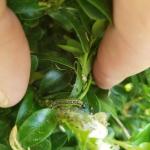 Box Tree Moth has been detected in the following Massachusetts communities: Bourne, Sandwich, and Barnstable. A map of these locations is available at MDAR’s Invasive Pest Dashboard. If you believe you have found this insect, please take a photo, note your location, and report it immediately to the MA Department of Agricultural Resources using their Report a Pest Form. Box tree moth caterpillars were reported to be active at certain locations on Cape Cod, MA as of the week of April 19th. For updates this week, see the Cape Cod Region Report.
Box Tree Moth has been detected in the following Massachusetts communities: Bourne, Sandwich, and Barnstable. A map of these locations is available at MDAR’s Invasive Pest Dashboard. If you believe you have found this insect, please take a photo, note your location, and report it immediately to the MA Department of Agricultural Resources using their Report a Pest Form. Box tree moth caterpillars were reported to be active at certain locations on Cape Cod, MA as of the week of April 19th. For updates this week, see the Cape Cod Region Report.
Need information about monitoring and trapping box tree moth? Check out this newly available Box Tree Moth Monitoring & Trapping fact sheet from UMass Extension.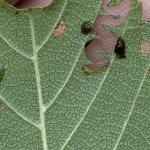
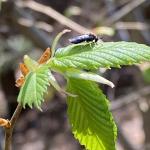 Elm Zigzag Sawfly has been detected in the following Massachusetts communities: Becket, Chester, Windsor, and Williamstown. If you believe you have found this insect, please take a photo, note your location, and report it immediately using MA DCR’s Massachusetts Elm Zigzag Sawfly Reporting Form. Elm zigzag sawfly adults are active as of 5/2/2024 at a previously infested site in Berkshire County (first detected in 2023). See photo courtesy of Nicole Keleher, MA DCR Forest Health Program.
Elm Zigzag Sawfly has been detected in the following Massachusetts communities: Becket, Chester, Windsor, and Williamstown. If you believe you have found this insect, please take a photo, note your location, and report it immediately using MA DCR’s Massachusetts Elm Zigzag Sawfly Reporting Form. Elm zigzag sawfly adults are active as of 5/2/2024 at a previously infested site in Berkshire County (first detected in 2023). See photo courtesy of Nicole Keleher, MA DCR Forest Health Program.- Emerald Ash Borer is well established across most of Massachusetts. A map of these locations from the MA Department of Conservation and Recreation is available.
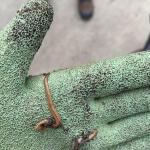
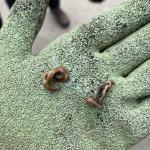 Hammerhead Worms: Also known as flatworms or land planarians, belong to Phylum Platyhelminthes (flat worms) rather than Arthropoda (arthropods) which makes them different from insects and their relatives. Class Insecta is the taxonomic classification of the Insects, whereas hammerhead worms belong to Class Turbellaria. A few common species of non-native hammerhead worms noted in New England include but are not limited to: Bipalium kewense, Bipalium adventitium, and Bipalium pensylvanicum. For more information, see this article in Hort Notes on Hammerhead Worms in New England.
Hammerhead Worms: Also known as flatworms or land planarians, belong to Phylum Platyhelminthes (flat worms) rather than Arthropoda (arthropods) which makes them different from insects and their relatives. Class Insecta is the taxonomic classification of the Insects, whereas hammerhead worms belong to Class Turbellaria. A few common species of non-native hammerhead worms noted in New England include but are not limited to: Bipalium kewense, Bipalium adventitium, and Bipalium pensylvanicum. For more information, see this article in Hort Notes on Hammerhead Worms in New England.
Sightings of these organisms have increased in recent years, possibly due to warming winters and wet summers. Hammerhead worms are predators that prefer to feed on earthworms; however, depending upon the species involved, they may not be an effective predator of certain species of jumping worms. Again in 2024, reports of hammerhead worms have come from parts of Massachusetts (in this case, Martha’s Vineyard; see photos) with questions about safety. Hammerhead worms are known to produce a neurotoxin (tetrodotoxin) which they use in self-defense and to subdue prey. Luckily, hammerhead worms do not produce enough tetrodotoxin to be lethal to humans, but if the neurotoxin comes into contact with exposed skin, irritation may occur. It is advised that handling hammerhead worms should be avoided, and hands or exposed skin be washed with soap and water following any accidental contact.- Jumping Worms are non-native earthworms that impact natural ecosystems. Available resources include a fact sheet about earthworms in Massachusetts and jumping worm FAQ’s.
- Spotted Lanternfly now has established populations in the following locations in Massachusetts: Holyoke, Springfield, West Springfield, Agawam, Fitchburg, Worcester, Shrewsbury, Southborough, Ashland, Wellesley, Weston, and Chelmsford. The MA Department of Agricultural Resources reports that spotted lanternfly egg hatch has begun in Holyoke and Springfield, MA as of 5/14/2024. Now is the time to monitor egg masses and areas nearby for emerging early instar nymphs (immatures). If you believe you have found this insect, please take a photo, note your location, and report it immediately using the Spotted Lanternfly Report Form. Available resources include a map of spotted lanternfly locations in Massachusetts from the MA Department of Agricultural Resources, MDAR’s spotted lanternfly fact sheet, UMass Extension’s Spotted Lanternfly Management Guide, and an SLF InsectXaminer episode.
Medically Important Pests:
- Ticks are a serious public health concern and may be active in managed landscapes any time temperatures are above freezing. Encounters with deer ticks can increase in New England in April, October, and November; however, precautions should be taken year-round to prevent tick bite exposure. Available resources include tick information from Cape Cod Cooperative Extension, personal protective measures, and a list of potential tick testing resources. The New England Center of Excellence in Vector-Borne Diseases (NEWVEC) also provides the latest tick information and resources.
- Mosquitoes and the diseases they vector are also a serious public health concern in Massachusetts by summer. Available resources include Mosquito Repellents from the Department of Public Health and Prevent Mosquito Bites from the Centers for Disease Control and Prevention. The Massachusetts Department of Public Health tests for Eastern Equine Encephalitis (EEE) and West Nile Virus (WNV) from June to October. Beginning in June, Massachusetts risk maps will be available.
- Wasps/Hornets: Many wasps are predators of other arthropods, including pest insects such as certain caterpillars that feed on trees and shrubs. Adult wasps hunt prey and bring it back to their nest where young are being reared as food for the immature wasps. A common such example are the paper wasps (Polistes spp.) who rear their young on chewed up insects. Paper wasps can sting, and will defend their nests, which are open-celled paper nests that are not covered with a papery “envelope”. These open-celled nests may be seen hanging from eaves or other outdoor building structures. Aerial yellow jackets and hornets create large aerial nests that are covered with a papery shell or “envelope”. Common yellow jacket species include those in the genus Vespula. Dolichovespula maculata is commonly known as the baldfaced hornet, although it is not a true hornet. The European hornet (Vespa crabro) is three times the size of a yellow jacket and may be confused for the northern giant hornet (Vespa mandarinia). The European hornet is known to Massachusetts, but the northern giant hornet is not. If you are concerned that you have found or photographed a northern giant hornet, please report it using the MA Department of Agricultural Resources Report Pest Sightings page. Some people are allergic to stinging insects, so care should be taken around wasp/hornet nests. Unlike the European honeybee (Apis mellifera), wasps and hornets do not have barbed stingers and therefore can sting repeatedly when defending their nests. It is best to avoid them and, if that cannot be done and assistance is needed to remove them, consult a professional.
Tree & Shrub Insect & Mite Pest Suggested Scouting:
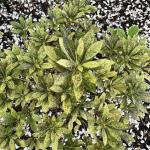 Andromeda Lace Bug is most commonly encountered on Japanese andromeda, however other host plants may be impacted. Most activity from this insect occurs between late May through September, with several generations occurring per year. Both nymphs and adults feed on host plant leaf undersides and cause white/yellow-colored spots or chlorosis to occur on host plant leaf surfaces. This image from 5/9/2024 (Boston, MA) shows Pieris japonica ‘Cavatine’ with old andromeda lace bug feeding damage from 2023 and possible winter injury. Samples were submitted to the UMass Extension Plant Diagnostic Lab. As of now, the new growth is starting to show damage as well, after developing without it. Boston, MA was at 132 GDD’s on 5/12/2024 and andromeda lace bug is known to begin activity by 120 GDD’s. (Image courtesy of Susan Shafer.)
Andromeda Lace Bug is most commonly encountered on Japanese andromeda, however other host plants may be impacted. Most activity from this insect occurs between late May through September, with several generations occurring per year. Both nymphs and adults feed on host plant leaf undersides and cause white/yellow-colored spots or chlorosis to occur on host plant leaf surfaces. This image from 5/9/2024 (Boston, MA) shows Pieris japonica ‘Cavatine’ with old andromeda lace bug feeding damage from 2023 and possible winter injury. Samples were submitted to the UMass Extension Plant Diagnostic Lab. As of now, the new growth is starting to show damage as well, after developing without it. Boston, MA was at 132 GDD’s on 5/12/2024 and andromeda lace bug is known to begin activity by 120 GDD’s. (Image courtesy of Susan Shafer.)- Arborvitae Leafminer moths appear from mid-June to mid-July and lay their eggs. Eggs hatch and larvae enter the leaves where they feed, often unnoticed until January or February when browned leaf tips become more apparent. Feeding from this insect is sometimes confused for winter injury, and vice versa.
- Azalea Lace Bug is a pest of both deciduous and evergreen azaleas (Rhododendron spp.), however resistance has been reported in Rhododendron atlanticum, R. arborescens, R. canescens, R. periclymenoides, and R. prunifolium. The insects feed on host plant leaf undersides, and cause chlorosis on leaf surfaces. Azalea lace bugs are active from 120+ GDD’s throughout the summer.
- Azalea Sawflies is a common name that might refer to three different species of sawflies that feed on azaleas. Adults of Amauronematus azaleae are often present in May and laying eggs which hatch into larvae that typically mature by July 1st. At that time, they finish feeding and drop to the soil to pupate. These green larvae feed on the edges of host plant leaves and may defoliate the plant.
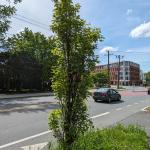
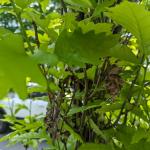

Bagworm is overwintering on Juniperus spp., Thuja spp., Quercus spp., Platanus spp., and others as 500-1000 eggs can be found in the bags of last season’s deceased females. Now is the time to remove and destroy overwintering bags of eggs prior to egg hatch at approximately 600 GDD’s (approx. mid-June). As of 5/17/2024 in Amherst, MA, bagworm eggs have not yet hatched. Remove overwintered bags and split open to view eggs within. If viable, the eggs will be filled with fluid. Bags are tough, and scissors may help with dissecting.- Black Turpentine Beetle overwinters as an adult in the bark of its host plants. Adults may become active as temperatures rise, typically by mid-April to mid-May. Attacked host trees may ooze 1.6 inch diameter red or white masses of pitch from the lower 6 feet of the trunk. Pitch pine, eastern white pine, and other species of pine or spruce may be hosts for this insect. Frequently an issue on stressed trees in eastern Massachusetts. Favored by drought or flooding conditions.

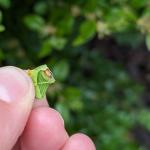 Boxwood Leafminer adult emergence occurs by mid-May, with pupal cases left behind clinging to leaves. Boxwood leafminer pupae were found in boxwood leaves in Berkshire County (Dalton, MA) on 5/11/2024. Shake bushes to detect flying adults. Resistant varieties of boxwood are available; see preceding link.
Boxwood Leafminer adult emergence occurs by mid-May, with pupal cases left behind clinging to leaves. Boxwood leafminer pupae were found in boxwood leaves in Berkshire County (Dalton, MA) on 5/11/2024. Shake bushes to detect flying adults. Resistant varieties of boxwood are available; see preceding link.- Boxwood Mite feeds on upper and lower leaf surfaces of Buxus spp. hosts. Overwintered eggs hatch into larvae in the spring, which mature into nymphs and eventually adults. The entire life cycle takes approximately 18-21 days. Most feeding injury occurs in the spring and hosts may appear off-color.
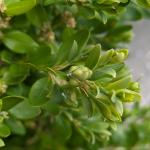
 Boxwood Psyllid nymphs have overwintered within eggshells inserted between bud scales last summer. As soon as buds expand, nymphs will emerge and begin feeding on Buxus spp. developing buds and leaves. Upward cupping and yellowing of leaves can be a sign of previous or current season’s damage. Boxwood psyllids are actively feeding in Berkshire County (Dalton, MA) as seen on 5/11/2024. White, waxy wool created by the insects can be seen in new growth that has already cupped around the insects.
Boxwood Psyllid nymphs have overwintered within eggshells inserted between bud scales last summer. As soon as buds expand, nymphs will emerge and begin feeding on Buxus spp. developing buds and leaves. Upward cupping and yellowing of leaves can be a sign of previous or current season’s damage. Boxwood psyllids are actively feeding in Berkshire County (Dalton, MA) as seen on 5/11/2024. White, waxy wool created by the insects can be seen in new growth that has already cupped around the insects.- Cankerworms can be found feeding on similar host plants in the spring, despite fall and spring cankerworm being different species of insects. Spring cankerworm adult moths are active in February and March, laying masses of 100 or so eggs in the rough bark of larger branches or the trunk of the host plant. Fall cankerworm adults laid their masses of eggs on host plant branches and twigs, back in late November and early December of last year (sometimes the current year’s January). Egg hatch of both species will occur by approximately mid-May, with caterpillar feeding through roughly the end of June.
- Cooley Spruce Gall Adelgid typically overwinters as an immature female near spruce twig terminals. By early spring, this female matures into a stem mother which will lay hundreds of eggs on lateral terminals. Following egg hatch, nymphal feeding induces gall formation on spruce hosts. Green galls on spruce may be removed and destroyed. On Douglas fir, the Cooley spruce gall adelgid’s alternate host, look for woolly masses in the spring and distorted or crooked needles. Do not plant spruce and Douglas fir close together when possible.
- Dogwood Borer is a species of clearwing moth whose larvae bore not only into dogwood (Cornus), but hosts also include flowering cherry, chestnut, apple, mountain ash, hickory, pecan, willow, birch, bayberry, oak, hazel, myrtle, and others. Kousa dogwood appears to be resistant to this species. Signs include the sloughing of loose bark, brown frass, particularly near bark cracks and wounds, dead branches, and adventitious growth. The timing of adult emergence can be expected when dogwood flower petals are dropping and weigela begins to bloom. Adult moth flights continue from then until September.
- Dogwood Sawfly overwinters as a larva in an overwintering “cell” created in soft, decaying wood material. Pupation occurs in the spring, and adults may emerge by late May through July. Eggs are laid in the underside of the host plant leaf, in groups of 100 or more.
- Eastern Tent Caterpillar overwintering eggs hatch in the spring and caterpillars emerge as cherry leaves begin to open. Anecdotally, eastern tent caterpillar activity has been more noticeable in Massachusetts in 2024. Tents and caterpillars in warm locations are large at this time.
- Elm Leaf Beetle overwinters as an adult in protected areas, such as the loose bark of trees. Sometimes, they enter homes in search of a safe winter haven, and become a nuisance. As host plant leaves emerge, beetles fly back to chew small, semi-circular holes in the leaves. Eggs are laid in clusters on leaves and resemble pointy footballs. Each female can lay 600-800 eggs.

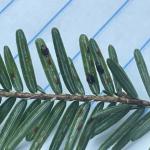 Elongate Hemlock Scale is primarily a pest of hemlock and fir. Overwintered fertilized females or their eggs will become active with warming temperatures, with egg hatch generally occurring by the end of May or the beginning of June. At that time, crawlers will be present before they settle to feed on a needle. Colletotrichum fioriniae was observed on elongate hemlock scales in Lynnfield, MA on 2/23/2024 and again in Manchester, MA on 3/19/2024 by Richard Grant (see photos). C. fioriniae is an endophytic fungus that lives within the needles of hemlock. Up to 90% mortality can occur in elongate hemlock scale if this fungus invades the insect. Scales appear coated in a black material, looking similar to sooty mold (it is not sooty mold). This fungus was reported as active in elongate hemlock scale populations in western MA in 2023 as well.
Elongate Hemlock Scale is primarily a pest of hemlock and fir. Overwintered fertilized females or their eggs will become active with warming temperatures, with egg hatch generally occurring by the end of May or the beginning of June. At that time, crawlers will be present before they settle to feed on a needle. Colletotrichum fioriniae was observed on elongate hemlock scales in Lynnfield, MA on 2/23/2024 and again in Manchester, MA on 3/19/2024 by Richard Grant (see photos). C. fioriniae is an endophytic fungus that lives within the needles of hemlock. Up to 90% mortality can occur in elongate hemlock scale if this fungus invades the insect. Scales appear coated in a black material, looking similar to sooty mold (it is not sooty mold). This fungus was reported as active in elongate hemlock scale populations in western MA in 2023 as well.- Euonymus Caterpillar tiny, overwintered larvae have spent their time beneath eggshells from last year. As temperatures increase in the spring, groups of caterpillars will begin feeding on newly emerging Euonymus spp. leaves. Additional resources include an InsectXaminer episode about euonymus caterpillar.
- Euonymus Scale overwinters as a fertilized female. Eggs are laid beneath dark brown female scale covers in the early spring. Egg hatch occurs over a 2-3 week period, with crawlers present by early June. While Euonymus spp. host plants are preferred, additional host plants have been reported.
- European Elm Scale is a non-native scale that is widespread in North America on native and European elms, in addition to hackberry and Zelkova. Adult females are black with a ring of white fibers around their bodies and may be found in branch forks or rough/creviced areas of the bark. By the end of June, females will produce eggs that hatch into crawlers. Crawlers will disperse to the underside of elm leaves and leaf midveins to feed.

 European Pine Sawfly eggs have overwintered in slits in last year’s needles. Egg hatch begins in approximately late-April and early May. Young European pine sawfly caterpillars were seen feeding in Berkshire County (Dalton, MA) on 5/11/2024. Look for tiny, gray-green larvae with black heads feeding on favored host plants such as Jack, Japanese red, Mugo, red, Scots, or Table Mountain pine. Sawfly larvae will feed until roughly early June, at which time they drop to the ground to pupate.
European Pine Sawfly eggs have overwintered in slits in last year’s needles. Egg hatch begins in approximately late-April and early May. Young European pine sawfly caterpillars were seen feeding in Berkshire County (Dalton, MA) on 5/11/2024. Look for tiny, gray-green larvae with black heads feeding on favored host plants such as Jack, Japanese red, Mugo, red, Scots, or Table Mountain pine. Sawfly larvae will feed until roughly early June, at which time they drop to the ground to pupate.- Fletcher Scale is a soft scale pest of yew, juniper, and arborvitae. Feeding scales, especially on yew, result in honeydew and sooty mold, needle yellowing, and at times, premature needle drop. There is one generation per year. Nymphs develop and adult females lay eggs (on average 500-600) in May that hatch by June. Dead females conceal egg masses beneath. Crawlers migrate short distances to branches and may be concentrated on certain branches of a particular plant.
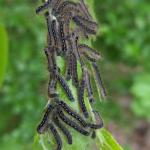 Forest Tent Caterpillar egg masses overwinter and will hatch as leaves expand in the spring. Small caterpillars will search for expanding flower and leaf buds to begin feeding on. In warmer locations of Massachusetts, forest tent caterpillars are large and may be reaching maturity. On 5/21/2024 in Chesterfield, MA, a group of much smaller, younger instar forest tent caterpillars was observed.
Forest Tent Caterpillar egg masses overwinter and will hatch as leaves expand in the spring. Small caterpillars will search for expanding flower and leaf buds to begin feeding on. In warmer locations of Massachusetts, forest tent caterpillars are large and may be reaching maturity. On 5/21/2024 in Chesterfield, MA, a group of much smaller, younger instar forest tent caterpillars was observed.- Hemlock Looper collectively refers to two species of geometrid (inchworm; looper) caterpillars. Overwintered eggs hatch by late May or early June, at which time young larvae begin their messy feeding on host plant needles. Hemlock and balsam fir are preferred hosts.
- Hemlock Woolly Adelgid has been favored this winter by the mild temperatures we’ve experienced in Massachusetts, according to the MA Department of Conservation and Recreation. Very little overwintering mortality has been measured at sites sampled across the state.
- Holly Leafminer is the common name of up to seven species of leaf mining flies that feed on holly (Ilex spp). Phytomyza ilicicola is usually referred to as the native holly leafminer. This species is known to feed on Ilex opaca, I. crenata, and related cultivars; however, it only lays its eggs in American holly (Ilex opaca). Some research suggests that the native holly leafminer may lay its eggs in other Ilex species, but that the larvae are unable to complete their development. Adult flies are known to emerge over a period of 6 or so weeks in the spring by mid-May (192-298 GDD’s, base 50°F). Phytomyza ilicis is usually only referred to as the holly leafminer, and it is a non-native species introduced from Europe and only feeds on Ilex aquifolium. (The native holly leafminer does not develop on I. aquifolium.) The biology and damage this insect causes is similar to that of the native holly leafminer, with the exception of the fact that eggs are laid in the midvein of the leaf and young larvae tunnel in the vein until the fall. Adults may be present mid-late May (246-448 GDD’s, base 50°F).
- Honeylocust Plant Bug feeding results in tiny yellowish-brownish spots on leaves, leaf distortion, and in some cases, defoliation. (There are at least 7 species of plant bugs that feed on honeylocust, Gleditsia triacanthos.) There is one generation per year. Immatures and adults feed on foliage and light to moderately damaged foliage may persist throughout the growing season. Honeylocust plant bugs overwinter as eggs laid just beneath the bark surface of 2 and 3 year old twigs. Eggs hatch just after vegetative buds of the host begin to open. Young nymphs crawl to the opening leaflets and begin feeding and the most significant damage occurs at that time, when the insect is hidden from view. Nymphs develop into adults around May-July. This insect can be targeted between 58-246 GDD’s, base 50°F.
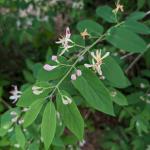
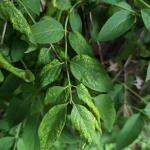
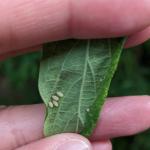 Honeysuckle Aphid is the likely culprit causing leaf curling seen in Williamsburg, MA on honeysuckle on 5/17/2024. This European species of aphid was first detected in North America in Quebec in 1976 and Illinois in 1981. Since then, it has been detected in New England and spread rapidly elsewhere in the United States, likely anywhere bush honeysuckle is grown. Green-colored aphids may be found on the newly opened leaves of host plants in the spring. Look for stunted and curled leaves.
Honeysuckle Aphid is the likely culprit causing leaf curling seen in Williamsburg, MA on honeysuckle on 5/17/2024. This European species of aphid was first detected in North America in Quebec in 1976 and Illinois in 1981. Since then, it has been detected in New England and spread rapidly elsewhere in the United States, likely anywhere bush honeysuckle is grown. Green-colored aphids may be found on the newly opened leaves of host plants in the spring. Look for stunted and curled leaves.- Hydrangea Leaftier caterpillars use silk applied to the edges of two newly expanding hydrangea leaves to tie them together to create an envelope-like structure within which they feed. Search the tips of plant stems. Envelope or purse-like structures may be pulled apart and caterpillars detected within. Caterpillars may mature and pupate by June.
- Imported Willow Leaf Beetle adults overwinter in loose bark or other sheltered areas near susceptible Salix and Populus spp. host plants. Once the host plant leaves emerge in the spring, adults will begin to feed and lay tiny, yellow eggs in clusters on leaf undersides. Additional resources include an InsectXaminer episode about imported willow leaf beetle.
- Lecanium Scales, including most notably in Massachusetts, the oak lecanium, are soft scales that overwinter on host plant twigs as second instar immatures. In the spring, these immatures begin feeding and mature into hemispherical shaped adult females who lay their eggs by late May and into June. Between April and May, much honeydew (sugary excrement) may be produced by the active adult females.
- Lilac Borer is a clearwing moth pest of lilac, privet, fringetree, and ash. (It is also known as the ash borer, not to be confused with the emerald ash borer.) Adults mimic paper wasps. Larvae are wood-boring, and signs and symptoms include branch dieback, holes, and occasionally, sawdust-like frass accumulated on bark. Larvae bore into stems, trunks, and branches, chewing an irregularly shaped entrance hole. Peak adult moth flights may occur in the northern portion of this insect’s range in June and is usually over by August 1st. Pheromone traps can be used to time adult emergence. Adult females lay flattened, oval, and tan eggs that are deposited singly or in clusters on bark crevices, ridges, and sometimes smooth bark; but usually laid in or near wounds in the bark. On average, 395 eggs are laid by each female. After hatch, larvae chew into the bark and feed laterally and then vertically in phloem tissue. Larvae overwinter in tunnels in the final instar and resume feeding in the spring. Adults emerge through a round exit hole (4-5 mm. in diameter). This insect may be targeted between 200-299 GDD’s, base 50°F.
- Lily Leaf Beetle, while not a pest of trees and shrubs, can be an important insect found in ornamental landscapes. As soon as lilies break through the ground in the spring, bright red overwintered adult beetles begin feeding on the foliage. This typically occurs in April, with adults mating and laying eggs by May; 250-450 eggs may be laid per female. Additional resources include an InsectXaminer episode about lily leaf beetle.
- Magnolia Scale overwinters as nymphs (immatures) found on 1 and 2-year old twigs of the host plant. Nymphs begin feeding as temperatures warm in the spring, molting once by late April or May and again by early June.
- Oak Apple Galls: Several species of gall wasps cause structures referred to as oak apple galls. A common species mentioned in Johnson and Lyon (1991) is Amphibolips confluenta, which forms large galls that are attached to the midrib or petiole of oak leaves. Additional species in this genus are known to cause oak apple galls, including A. quercusinanis and A. quercusspongifica. A. confluenta galls are filled with a spongy mass that may be cut with a knife. A single wasp larva is found within a hard, seed-like cell in the center of the gall. As the gall dries, the spongy interior becomes a mass of fibers radiating from this central cell to the thin shell of the gall. These galls do no damage to their host plants and do not require management. Not enough is known about gall forming insects and there is so much to learn! Oak apple galls were green and of various sizes in Sandy Hook, CT on 5/18/2024.
- Pitch Mass Borer overwinters in the pitch mass found on the host plant. This insect tunnels beneath the bark, into the cambium. It may take up to two years for the pitch mass borer to mature. Pupation typically occurs by the end of May through June, in time for adult clearwing moth emergence in July and August.
- Privet Thrips are a non-native insect pest of privet, lilac, and ash. Thrips feed on the leaves of privet, causing them to appear gray in color made up of chlorotic spots. Immature thrips may be viewed with magnification on the undersides of host plant leaves. Several generations per year may be possible throughout the summer.
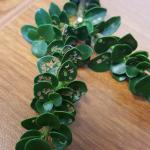
 Redheaded Flea Beetle (Systena frontalis) has been identified as a native pest of nurseries in many locations in the eastern United States. Suspected redheaded flea beetle damage was seen on Ilex crenata 'Dwarf Pagoda' (Dwarf Pagoda Japanese holly) on 3/27/2024 that was purchased in Massachusetts but may have originated in NJ. While identification of this species of insect is uncertain based on host plant damage alone, it appears to be a reasonable and educated assumption. Redheaded flea beetles are known to feed on a wide variety of host plants. These include but are not limited to: cabbage, beans, beets, blueberries, and other agricultural crops as well as Physocarpus, Weigelia, Cornus, Forsythia, Itea, Hydrangea, and Ilex. Adult beetles are active and feed from approximately late-June to mid-September on the upper and lower leaf surfaces of their hosts. This can cause damage that looks like skeletonization and eventually holes in the leaves. Leaves appear covered in brown patches as in these photos. This damage was caused last season on this evergreen plant.
Redheaded Flea Beetle (Systena frontalis) has been identified as a native pest of nurseries in many locations in the eastern United States. Suspected redheaded flea beetle damage was seen on Ilex crenata 'Dwarf Pagoda' (Dwarf Pagoda Japanese holly) on 3/27/2024 that was purchased in Massachusetts but may have originated in NJ. While identification of this species of insect is uncertain based on host plant damage alone, it appears to be a reasonable and educated assumption. Redheaded flea beetles are known to feed on a wide variety of host plants. These include but are not limited to: cabbage, beans, beets, blueberries, and other agricultural crops as well as Physocarpus, Weigelia, Cornus, Forsythia, Itea, Hydrangea, and Ilex. Adult beetles are active and feed from approximately late-June to mid-September on the upper and lower leaf surfaces of their hosts. This can cause damage that looks like skeletonization and eventually holes in the leaves. Leaves appear covered in brown patches as in these photos. This damage was caused last season on this evergreen plant.- Rhododendron Borer is one of the smallest of the native clearwing moths. Adult emergence may begin in May and can last through July, depending upon local temperatures. Rhododendron are preferred host plants, with the larvae of this species boring into stems, often near the base of plants. Injured plant parts may be more attractive to these insects.

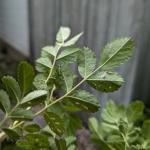 Roseslugs is a common name for at least two species of sawflies whose larvae may be found feeding on the foliage of roses. These small larvae will skeletonize the upper leaf surface and leave a “windowpane”-like pattern behind. If present in large numbers, entire shrubs can be defoliated. Monitor for feeding larvae from the end of May through June. Roseslugs are still feeding as of 5/17/2024 in Williamsburg, MA as pictured here.
Roseslugs is a common name for at least two species of sawflies whose larvae may be found feeding on the foliage of roses. These small larvae will skeletonize the upper leaf surface and leave a “windowpane”-like pattern behind. If present in large numbers, entire shrubs can be defoliated. Monitor for feeding larvae from the end of May through June. Roseslugs are still feeding as of 5/17/2024 in Williamsburg, MA as pictured here.- Southern Pine Beetle has been trapped in Massachusetts since 2015. By 2022 and 2023, southern pine beetle has reached outbreak conditions in small areas of the state, killing pitch pine (Pinus rigida). (Particularly on Martha’s Vineyard and Nantucket islands in MA.) If you believe you have found infested pitch pine in Massachusetts, please report southern pine beetle using the Massachusetts Southern Pine Beetle Reporting Form from MA DCR.
- Spruce Bud Scale overwinters as an immature scale on the undersides of host plant needles. Once spring temperatures warm, the dormant scales become active by late March and in April female spruce bud scales move to host plant twigs. Adult females are reddish-brown and round, and usually found at the base of new twig growth. In this location, they finish maturing and eggs are retained in the female spruce bud scale body cavity where, eventually, crawlers develop. These immature and mobile crawlers appear by approximately the beginning of June and may remain active through July. They then find suitable locations to settle and begin their feeding on the new growth of the plant. During this time, copious amounts of honeydew (sugary liquid excrement) may be excreted.
- Spruce Spider Mite is a cool season mite which causes most of its feeding damage on coniferous hosts in the spring and fall. Monitor for discolored needles and the mites themselves. Monitoring for spruce spider mite can be done by shaking 3-4 branches over a white piece of paper and viewing mites with a hand lens.
- Taxus Mealybug is commonly a pest of Taxus spp. in New England, but can also be found on dogwood, rhododendron, Prunus spp., maple, andromeda, and crabapple. First instar nymphs overwinter, and in April and May it might be difficult to find these insects. However, by mid-June the population can increase considerably. Taxus mealybug feeding can lead to sparse plants covered in honeydew (sugary liquid excrement).
- Tuliptree Scale is a soft scale pest of Liriodendron and Magnolia spp. among others. Second instar nymphs overwinter, begin feeding as temperatures warm in the spring, and mature into adults by the late spring/early summer.
- Viburnum Leaf Beetle larvae may be found anywhere on the leaves and usually in groups. When young, larvae feed on the undersides of the leaves. As they grow larger, they may feed on the upper surface. Larval development may take approximately 8-10 weeks to complete and 3 larval instars are reported. Pupae are yellowish and are found in the soil beneath the host plant. Adults emerge around the middle of July and are brown, smaller than the largest larvae (approximately ¼ inch), and will also feed on the leaves. Adults are present in the landscape until the first hard frost.
- White Pine Aphid is a large, black, long-legged aphid found on twigs and small branches of eastern white pine. Search for aphids beginning in May and June. As the season progresses, honeydew and sooty mold may coat branches and needles of the host plant.
- White Pine Weevil overwinters as an adult in the leaf litter in sheltered areas near host plants. As spring temperatures warm, adults fly to the leaders of Pinus and Picea spp. hosts where they mate, dig round holes in the bark, and deposit 1-5 tiny eggs in the cavity. Eggs hatch and the larvae tunnel as they feed, killing the previous season’s leader. Adult white pine weevils are active in March (through May), as soon as 7 GDD’s are reached. Infested terminals may begin to flag by June. Before June, but after adult emergence in the spring, remove and destroy flagging or crooked leaders on small trees. Prune out and destroy any infested terminals.
- White Spotted Pine Sawyer is a native longhorned beetle that is often confused for the invasive Asian longhorned beetle (see entry above). White spotted pine sawyer adults emerge in late May throughout July in MA. This insect completes its life cycle in weakened or recently dead conifers, particularly eastern white pine (Pinus strobus). It is not a significant pest. However, if you are unsure of the identification of a longhorned beetle, always take a photo and report it. You can report suspicious insects at the MA Department of Agricultural Resources Introduced Species Outreach Project Report a Pest Form.

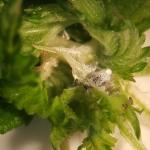 Woolly Apple Aphid overwinters as eggs in the cracks and crevices of Ulmus spp. host plants. As spring temperatures warm, these eggs hatch and stem mothers begin feeding on developing elm leaves. Their feeding and the feeding of the wingless nymphs they produce causes leaf distortion and a rosette to form on elm. If no elm is present, the aphids will complete their life cycle on apple year-round. Woolly apple aphid feeding distortion was seen on new elm foliage on the UMass Amherst campus on 5/1/2024.
Woolly Apple Aphid overwinters as eggs in the cracks and crevices of Ulmus spp. host plants. As spring temperatures warm, these eggs hatch and stem mothers begin feeding on developing elm leaves. Their feeding and the feeding of the wingless nymphs they produce causes leaf distortion and a rosette to form on elm. If no elm is present, the aphids will complete their life cycle on apple year-round. Woolly apple aphid feeding distortion was seen on new elm foliage on the UMass Amherst campus on 5/1/2024.- Woolly Beech Leaf Aphid overwinters as eggs in host plant bark crevices near buds. At budbreak, eggs hatch and wool covered aphids begin feeding on host plant leaf undersides (Fagus spp.). Even though aphid populations may be very noticeable, they seldom require chemical management.
- Woolly Elm Aphid overwinters as eggs hidden in cracks and crevices of elm bark. As leaves unfold in the spring, eggs hatch and young aphids feed on the underside of elm leaf tissue. These aphids mature and give birth to hundreds of additional females. Feeding causes leaves to curl around the aphids. Curled leaves may also turn reddish brown.
Beneficials/Non-Pests:
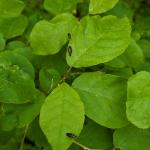
 Fire-colored Beetles are in the Family Pyrochroidae and there are at least 50 known species in the United States and Canada. The beetles pictured here from Chesterfield, MA were seen on 5/18/2024. Fire-colored beetles are found particularly in damp areas on flowers and vegetation. They may capture your attention if they are found in groups; however, they are most likely non-pests. Certain species of fire-colored beetles larvae feed on fungi. Some species are reported to be cannibalistic when present in large densities. They are not pests and should be preserved.
Fire-colored Beetles are in the Family Pyrochroidae and there are at least 50 known species in the United States and Canada. The beetles pictured here from Chesterfield, MA were seen on 5/18/2024. Fire-colored beetles are found particularly in damp areas on flowers and vegetation. They may capture your attention if they are found in groups; however, they are most likely non-pests. Certain species of fire-colored beetles larvae feed on fungi. Some species are reported to be cannibalistic when present in large densities. They are not pests and should be preserved.
Report by Tawny Simisky, Extension Entomologist, UMass Extension Landscape, Nursery & Urban Forestry Program
Landscape Weeds
For information about identification of weeds noted below, check out UMass Extension's Weed Herbarium.
Garlic mustard (Alliaria petiolata): This biennial weed is considered invasive in Massachusetts and other Northeast states. Second year plants are at the end of their flowering period and seedpods are still green. Green seedpods contain seeds that are not mature and lack reproductive ability. An herbicide application now will control the second-year plants before they produce viable seed as well as the first-year seeding plants that are germinating below the canopy of the second-year plants.
Crabgrass (and other annual grassy weed) management in turf: Continue to monitor turf areas for the emergence of crabgrass and other annual grassy weeds. Routine monitoring should be conducted on all turf areas whether they received a preemergence herbicide application or not. After crabgrass has germinated, it can be controlled with several postemergence herbicides. Postemergence herbicides vary in their ability to control crabgrass at different stages of growth. Determination of the predominant growth stage will dictate herbicide selection.
Japanese knotweed (Fallopia japonica): Do not attempt to control Japanese knotweed at this time, as herbicide applications are not effective in the early part of the growing season. In preparation for a late season herbicide application, cut or mow stands of knotweed to the ground in late May and early June. This practice is done to facilitate herbicide application by removing the dried stems from the previous year’s growth and will control plant height to make herbicide treatment easier in late summer. There is also some indication that the plant’s carbohydrate reserves may be reduced with this early season mowing.
Ground ivy (Glechoma hederacea) in turf and landscape: This often “tough-to-manage” weed is currently in full flower. Management of ground ivy is usually not effective during the early part of the growing season. The best control of ground ivy is achieved with an application of a broadleaf turf herbicide product that contains triclopyr in September and October. Ground ivy in landscape beds can be controlled now with a direct-spray application of glyphosate or glufosinate.
Scout for annual weeds in ornamental beds: Recent rainfall and warm weather has pushed summer annual weed germination along. If a preemergence herbicide was applied earlier in the season, now is a good time to begin determining if the application provided effective control. Treat these weeds before they get too large. Spot spraying with a non-selective herbicide (glyphosate or glufosinate) is usually a better strategy than hand-weeding as it does not break the mulch barrier.
Report by Randy Prostak, Weed Specialist, UMass Extension Landscape, Nursery, and Urban Forestry Program
Additional Resources
Pesticide License Exams - The MA Dept. of Agricultural Resources (MDAR) is now holding exams online. For more information and how to register, go to: https://www.mass.gov/pesticide-examination-and-licensing.
To receive immediate notification when the next Landscape Message update is posted, join our e-mail list or follow us on Facebook.
For a complete listing of landscape, nursery, and urban forestry program upcoming events, see our calendar at https://ag.umass.edu/landscape/upcoming-events.
For commercial growers of greenhouse crops and flowers - Check out UMass Extension's Greenhouse Update website.
For professional turf managers - Check out our Turf Management Updates.
For home gardeners and garden retailers - Check out our home lawn and garden resources.
Diagnostic Services
UMass Laboratory Diagnoses Landscape and Turf Problems - The UMass Extension Plant Diagnostic Lab is available to serve commercial landscape contractors, turf managers, arborists, nurseries and other green industry professionals. It provides woody plant and turf disease analysis, woody plant and turf insect identification, turfgrass identification, weed identification, and offers a report of pest management strategies that are research based, economically sound and environmentally appropriate for the situation. Accurate diagnosis for a turf or landscape problem can often eliminate or reduce the need for pesticide use. For sampling procedures, detailed submission instructions and a list of fees, see the Plant Diagnostic Laboratory web site.
Soil and Plant Nutrient Testing - The University of Massachusetts Soil and Plant Nutrient Testing Laboratory is located on the campus of the University of Massachusetts at Amherst. Testing services are available to all. The lab provides test results and recommendations that lead to the wise and economical use of soils and soil amendments. For more information, including current turn-around times, visit the UMass Soil and Plant Nutrient Testing Laboratory web site. The lab is currently accepting orders for Routine Soil Analysis (including optional Organic Matter, Soluble Salts, and Nitrate testing), Particle Size Analysis, Pre-Sidedress Nitrate (PSNT), Total Sorbed Metals, and Soilless Media (no other types of soil analyses available at this time). Check for current turnaround time. Please plan for the fact that date of receipt in the lab is affected by weekends, holidays, shipping time, and time for UMass Campus Mail to deliver samples to the lab.
Tick Testing - The UMass Center for Agriculture, Food, and the Environment provides a list of potential tick identification and testing options at https://ag.umass.edu/resources/tick-testing-resources.
Acknowledgements: UMass Extension gratefully acknowledges the support of the following funding sources for the production of the Landscape Message –
- The Massachusetts Nursery and Landscape Association Fund
- The Massachusetts Department of Conservation and Recreation, Award #ISADCR28219926UMA24A
- Stakeholders like you! The Landscape Message is partially supported by educational program user fees.





